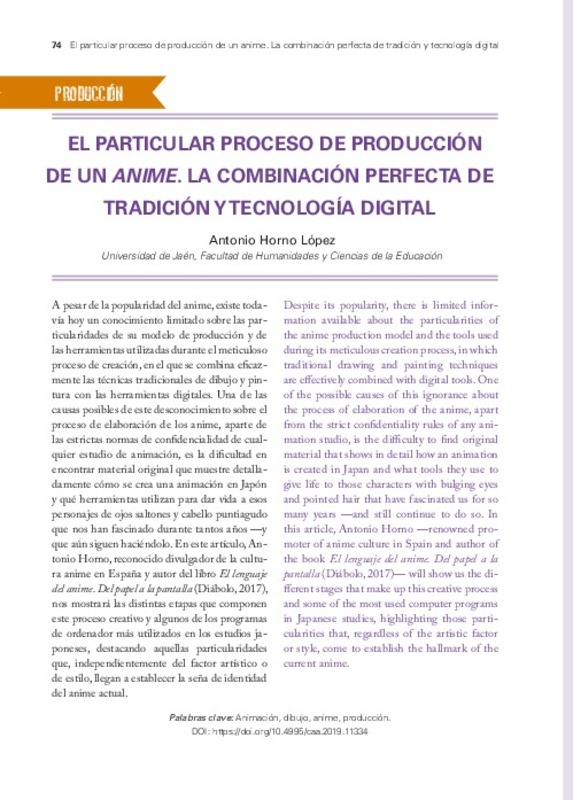JavaScript is disabled for your browser. Some features of this site may not work without it.
Buscar en RiuNet
Listar
Mi cuenta
Estadísticas
Ayuda RiuNet
Admin. UPV
El particular proceso de producción de un anime. La combinación perfecta de tradición y tecnología digital
Mostrar el registro sencillo del ítem
Ficheros en el ítem
| dc.contributor.author | Horno López, Antonio
|
es_ES |
| dc.date.accessioned | 2019-03-25T10:36:27Z | |
| dc.date.available | 2019-03-25T10:36:27Z | |
| dc.date.issued | 2019-03-14 | |
| dc.identifier.issn | 2173-6049 | |
| dc.identifier.uri | http://hdl.handle.net/10251/118507 | |
| dc.description.abstract | [EN] Despite its popularity, there is limited information available about the particularities of the anime production model and the tools used during its meticulous creation process, in which traditional drawing and painting techniques are effectively combined with digital tools. One of the possible causes of this ignorance about the process of elaboration of the anime, apart from the strict confidentiality rules of any animation studio, is the difficulty to find original material that shows in detail how an animation is created in Japan and what tools they use to give life to those characters with bulging eyes and pointed hair that have fascinated us for so many years —and still continue to do so. In this article, Antonio Horno —renowned promoter of anime culture in Spain and author of the book El lenguaje del anime. Del papel a la pantalla (Diábolo, 2017)— will show us the different stages that make up this creative process and some of the most used computer programs in Japanese studies, highlighting those particularities that, regardless of the artistic factor or style, come to establish the hallmark of the current anime. | es_ES |
| dc.description.abstract | [ES] A pesar de la popularidad del anime, existe todavía hoy un conocimiento limitado sobre las particularidades de su modelo de producción y de las herramientas utilizadas durante el meticuloso proceso de creación, en el que se combina eficazmente las técnicas tradicionales de dibujo y pintura con las herramientas digitales. Una de las causas posibles de este desconocimiento sobre el proceso de elaboración de los anime, aparte de las estrictas normas de confidencialidad de cualquier estudio de animación, es la dificultad en encontrar material original que muestre detalladamente cómo se crea una animación en Japón y qué herramientas utilizan para dar vida a esos personajes de ojos saltones y cabello puntiagudo que nos han fascinado durante tantos años —y que aún siguen haciéndolo. En este artículo, Antonio Horno, reconocido divulgador de la cultura anime en España y autor del libro El lenguaje del anime. Del papel a la pantalla (Diábolo, 2017), nos mostrará las distintas etapas que componen este proceso creativo y algunos de los programas de ordenador más utilizados en los estudios japoneses, destacando aquellas particularidades que, independientemente del factor artístico o de estilo, llegan a establecer la seña de identidad del anime actual. | es_ES |
| dc.language | Español | es_ES |
| dc.publisher | Universitat Politècnica de València | |
| dc.relation.ispartof | Con A de Animación | |
| dc.rights | Reconocimiento - No comercial - Sin obra derivada (by-nc-nd) | es_ES |
| dc.subject | Animación | es_ES |
| dc.subject | Dibujo | es_ES |
| dc.subject | Anime | es_ES |
| dc.subject | Producción | es_ES |
| dc.subject | Animation | es_ES |
| dc.subject | Drawing | es_ES |
| dc.subject | Production | es_ES |
| dc.title | El particular proceso de producción de un anime. La combinación perfecta de tradición y tecnología digital | es_ES |
| dc.title.alternative | The Particular Production Process of an Anime. The Perfect Combination of Tradition and Digital Technology | es_ES |
| dc.type | Artículo | es_ES |
| dc.date.updated | 2019-03-25T08:14:54Z | |
| dc.identifier.doi | 10.4995/caa.2019.11334 | |
| dc.rights.accessRights | Abierto | es_ES |
| dc.description.bibliographicCitation | Horno López, A. (2019). El particular proceso de producción de un anime. La combinación perfecta de tradición y tecnología digital. Con A de Animación. (9):74-83. https://doi.org/10.4995/caa.2019.11334 | es_ES |
| dc.description.accrualMethod | SWORD | es_ES |
| dc.relation.publisherversion | https://doi.org/10.4995/caa.2019.11334 | es_ES |
| dc.description.upvformatpinicio | 74 | es_ES |
| dc.description.upvformatpfin | 83 | es_ES |
| dc.type.version | info:eu-repo/semantics/publishedVersion | es_ES |
| dc.description.issue | 9 | |
| dc.identifier.eissn | 2173-3511 | |
| dc.description.references | ABIDIN, Dzaky Taufik (2016). "Penerapan "genga" dalam pembuatan film animasi pendek 2 dimensi fruits", en Semnasteknomedia online, 4 (1), pp. 7-12. | es_ES |
| dc.description.references | BASEEL, Casey, 2015. "Want to be an animator in Japan? Brace yourself for long hours, poverty as you start your career" (https://soranews24.com/2015/04/29/want-to-bean-animator-in-japan-brace-yourself-forlong-hours-poverty-as-you-start-your-career/ [acceso: septiembre de 2018]). | es_ES |
| dc.description.references | CGWORLD 2017, デジタル作画アニメーション (Digital Drawing Anime Production Site). Japan: Born Digital. | es_ES |
| dc.description.references | FREDERICK, Jim, 2003. "What's right with Japan?" (http://web.archive.org/web/20100403090055/http://www.time.com/time/asia/2003/cool_japan/story.html [acceso: septiembre de 2018]). | es_ES |
| dc.description.references | HANG LI, Chi, PATMORE, Chris, SCOTT-BARON, Hayden, 2006. Animación Manga. Manual de técnicas de anime, Barcelona: Acanto. | es_ES |
| dc.description.references | HANSON, Matt, 2005. Building sci-fi moviescapes: the science behind the fiction, Texas: Gulf Professional Publishing. | es_ES |
| dc.description.references | HARBOR BUSINESS ONLINE, 2016. "月 期放送アニメが「放送延期続出" (https://www.excite.co.jp/News/society_g/20161026/Harbor_business_114251.html [acceso: septiembre de 2018]). | es_ES |
| dc.description.references | KOI-NYA. 2013, "FicZone 2013: Entrevista a Kazuki" (https://www.koi-nya.net/2013/05/25/ficzone-2013-entrevista-akazuki-akane/ [acceso: septiembre de 2018]). | es_ES |
| dc.description.references | SEHNNG, 2015. "Shirobako's Glossary, with Pictures and Annotations" (http://archive.is/Y8yFZ#selection-67.0-67.51 [acceso: septiembre de 2018]). | es_ES |
| dc.description.references | SHARMA, Deepali, 2017. "Animation Production Process" (http://virtualschooldesk.com/animation-production-process/ [acceso: septiembre de 2018]). | es_ES |








